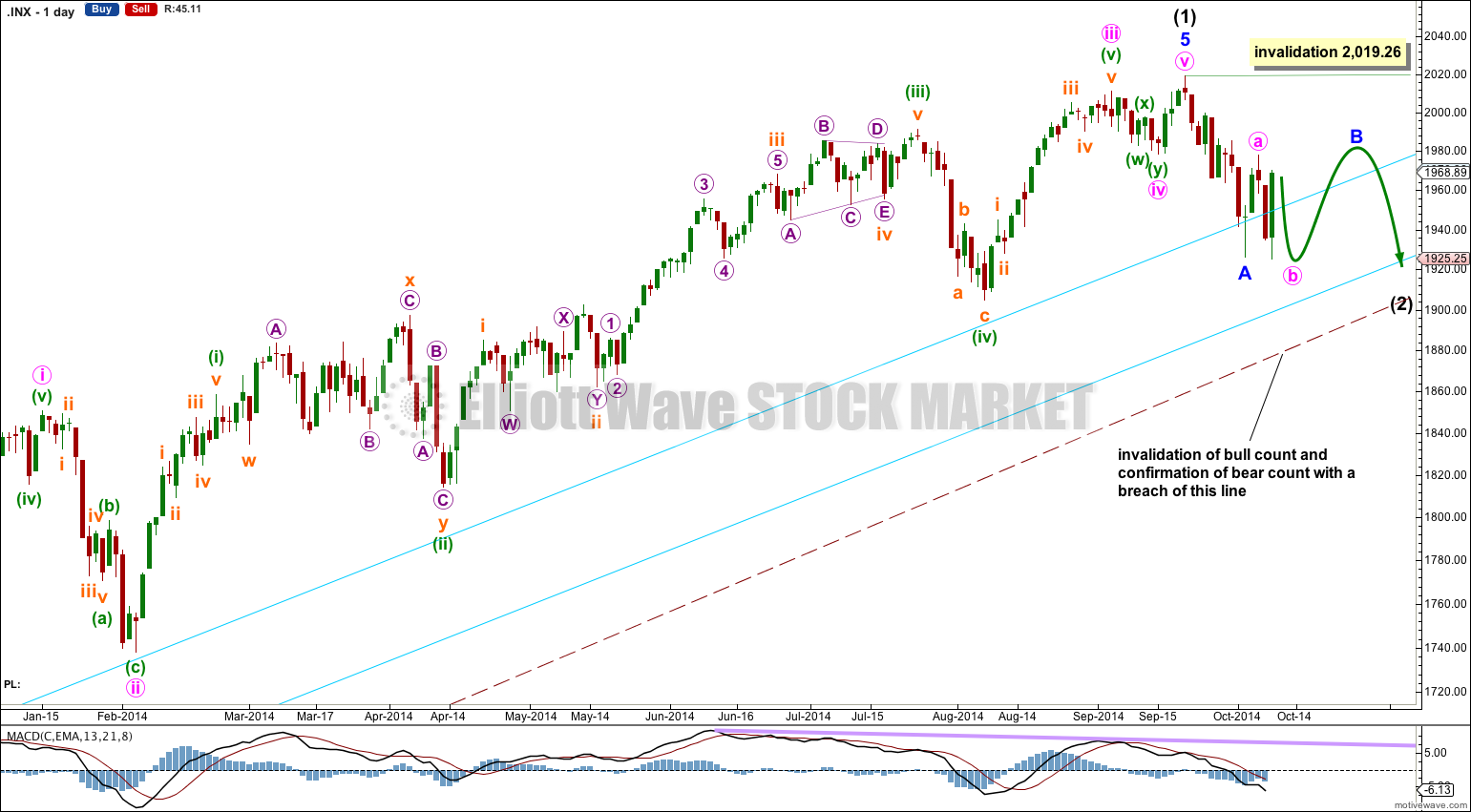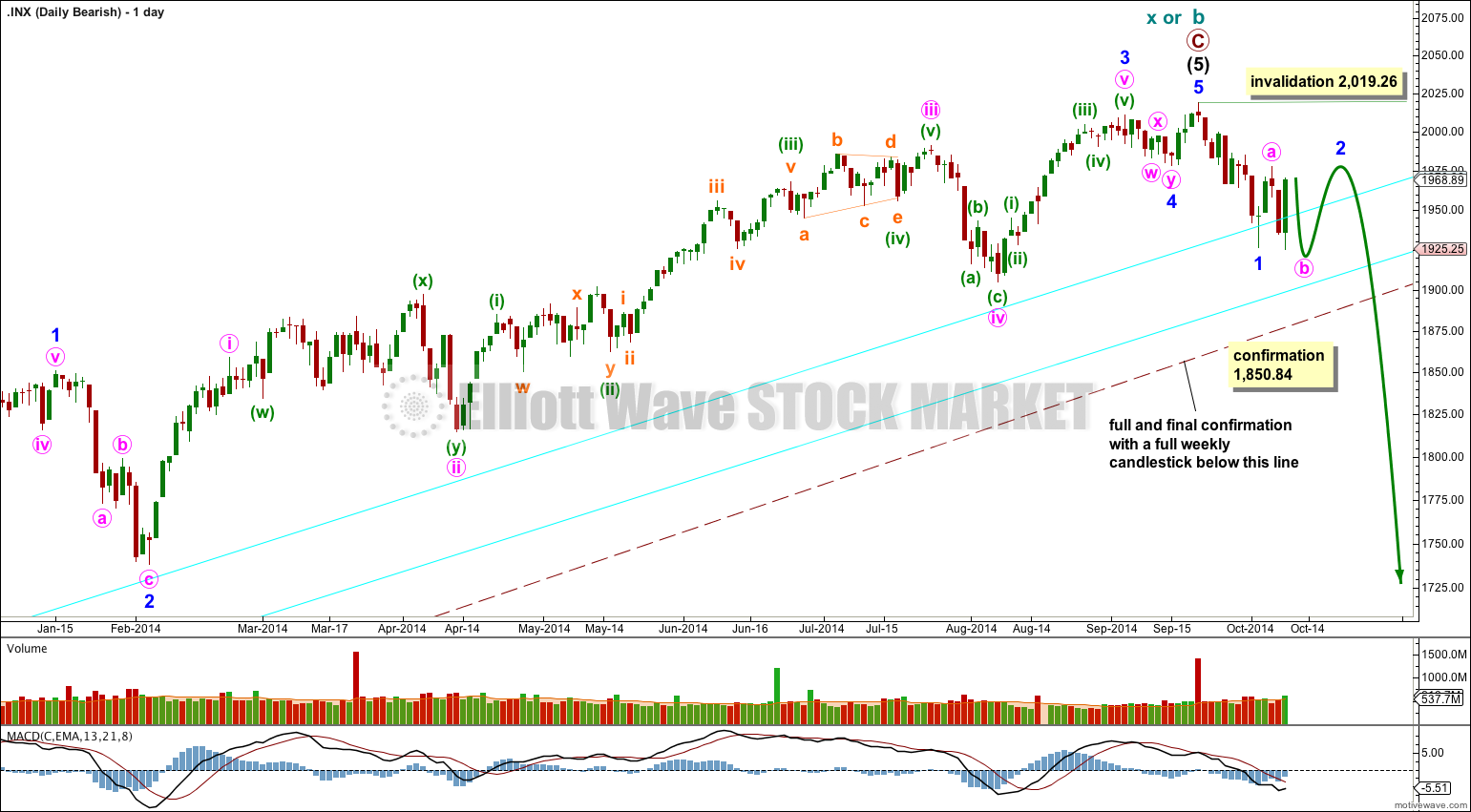Downwards movement below 1,926.03 was unexpected. This changes the wave count substantially.
Summary: It is most likely that intermediate wave (1) or cycle wave b (for the bearish wave count) is over. In the short term I expect a five down to 1,918.
Click on charts to enlarge.
Bullish Wave Count
The aqua blue trend lines are critical. Draw the first trend line from the low of 1,158.66 on 25th November, 2011, to the next swing low at 1,266.74 on 4th June, 2012. Create a parallel copy and place it on the low at 1,560.33 on 24th June, 2013. While price remains above the lower of these two aqua blue trend lines we must assume the trend remains upwards. This is the main reason for the bullish wave count being my main wave count.
There are a couple of things about this wave count of which I am confident. I see minor wave 3 within intermediate wave (1) as over at 1,729.86 (19th September, 2013). It has the strongest upwards momentum and is just 0.76 longer than 2.618 the length of minor wave 1. At 455 days duration this is a remarkably close Fibonacci ratio. The subdivisions within it are perfect.
Minor wave 5 is 20.24 points longer than 1.618 the length of minor wave 1. This is a 5.4% variation. I consider any variation less than 10% to be acceptable.
Ratios within minor wave 5 are: there is no Fibonacci ratio between minute waves i and iii, and minute wave v is 0.89 points longer than 0.146 the length of minute wave iii.
Minute wave ii is a single zigzag lasting 14 days. Minute wave iv may be seen as a double combination lasting 7 days.
The large maroon – – – channel is copied over from the weekly chart. It is drawn in exactly the same way on bull and bear wave counts. For the bull wave count this channel is termed a base channel about primary waves 1 and 2. A lower degree second wave should not breach the lower edge of a base channel drawn about a first and second wave one or more degrees higher. The lower maroon – – – trend line differentiates the bull and bear wave counts at cycle degree and monthly chart level.
I have taken another look at the movement for minute wave iv. It can be seen as a double zigzag (which I had previously) or as a double combination. The second structure in the double is an expanded flat and it moves price lower, but not by too much. This resolves the problem I had previously with the lack of alternation in structure between minute waves ii and iv. They are still somewhat disproportionate though.
The reanalysis of movement at the end of minute wave iv and beginning of minute wave v also resolves a couple of other small problems I had with my prior analysis of this movement.
Downwards movement from the high labeled intermediate wave (1) subdivides best as a five wave impulse with a triangle in the fourth wave position. This would be minor wave A within intermediate wave (2) and so intermediate wave (2) should be unfolding as a single zigzag or a double combination with the first structure a zigzag. Within the zigzag minor wave B may not move beyond the start of minor wave A.
Minor wave B is unfolding as a flat correction or a double combination with the first structure a flat. Within it minute wave a is ambiguous, but a new low below its start confirms it should be seen as a three.
Minute wave b is unfolding as a zigzag. This relies upon my analysis of minuette wave (a) downwards being correct; I am seeing this movement as a five wave impulse with a triangle in the fourth wave position. If minuette wave (a) is a five then minuette wave (b) may not move beyond its start above 1,977.84.
At 1,918 minuette wave (c) would reach equality in length with minuette wave (a). This would complete the zigzag for minute wave b. Thereafter, minute wave c should move price higher above the end of minute wave a at 1,977.84 to avoid a truncation.
When minor wave B of this larger zigzag for intermediate wave (2) is complete then I would calculate a target downwards for minor wave C to end. It should not break below the lower aqua blue trend line on the daily chart.
Bearish Wave Count
To see the difference between bull and bear wave counts they must be viewed on monthly charts here and video here.
The differentiation between the bull and bear wave count is the maroon – – – channel. For the bear wave count this channel is a corrective channel about cycle wave b or x zigzag. When a channel drawn about a zigzag is breached that provides trend channel confirmation that the zigzag is over and the next wave is underway.
If this trend line is breached by a full weekly candlestick below it and not touching it then this bear wave count would be my main wave count and I would then calculate downwards targets.
We should always assume the trend remains the same until proven otherwise; the trend is your friend. While price remains above the lower maroon – – – trend line I will assume that the S&P 500 remains within a bull market.
This analysis is published about 08:42 p.m. EST.



